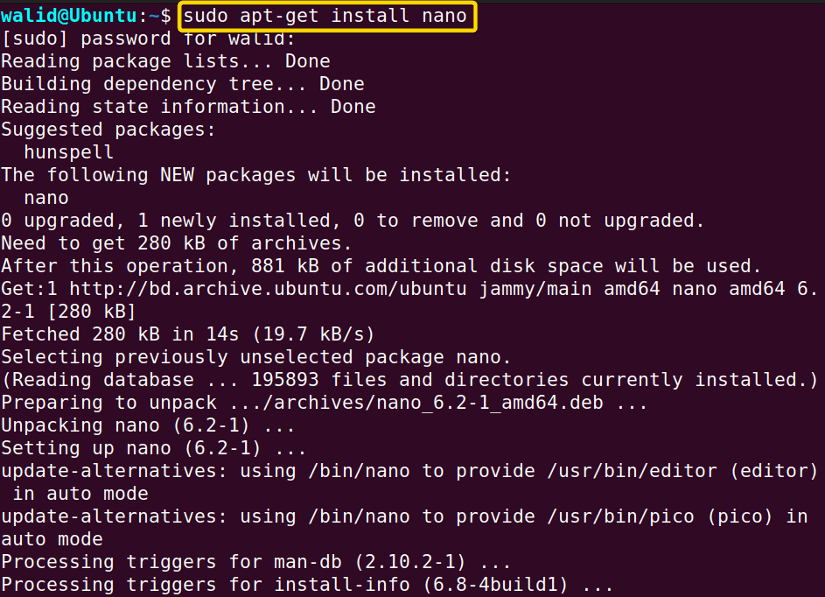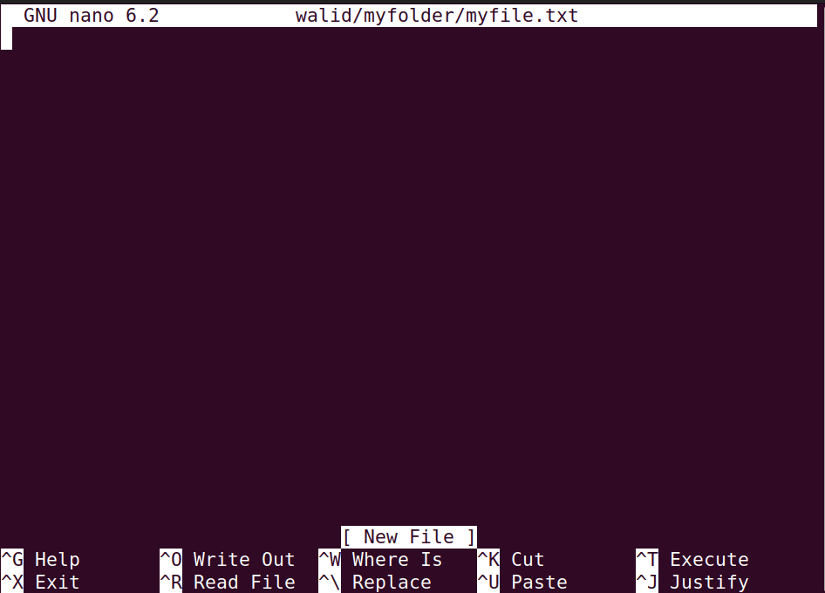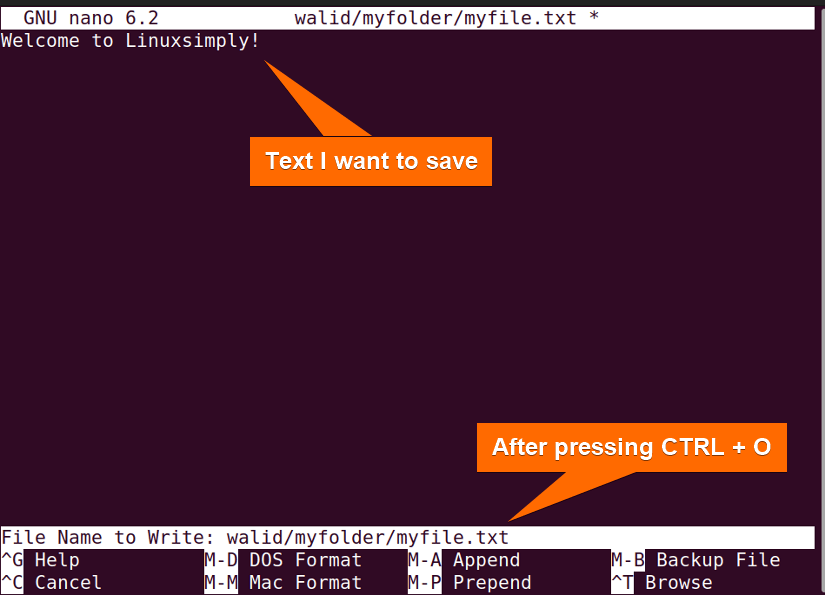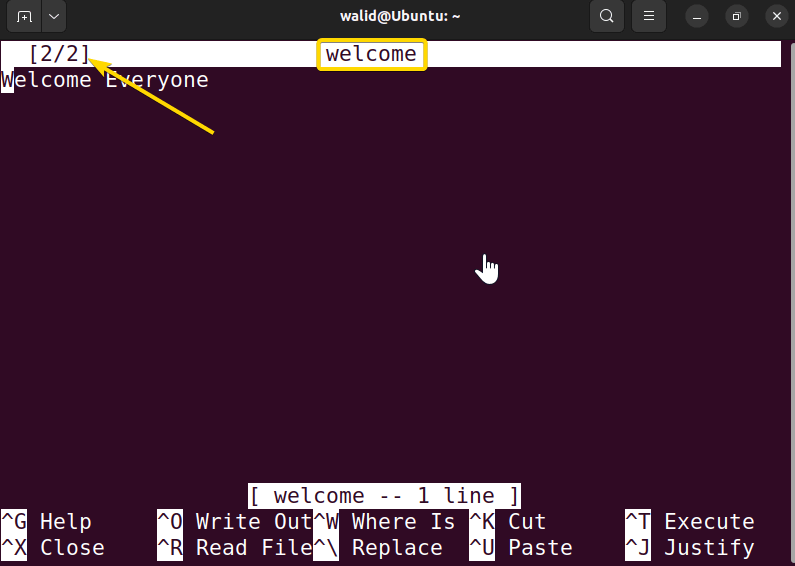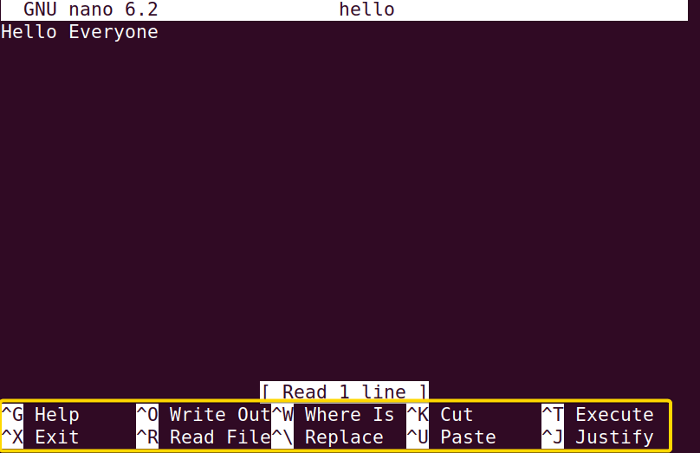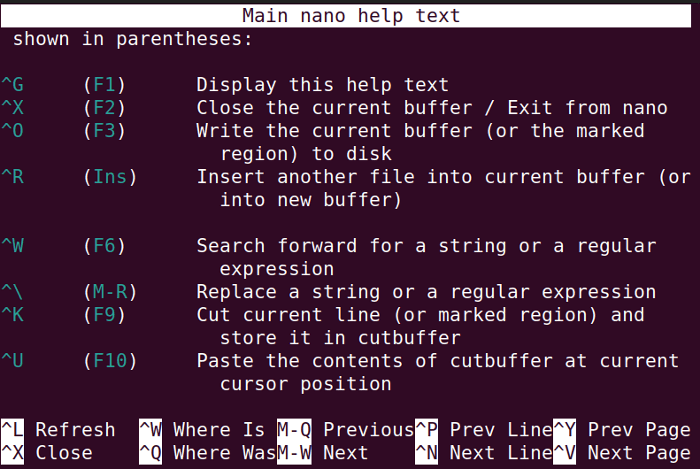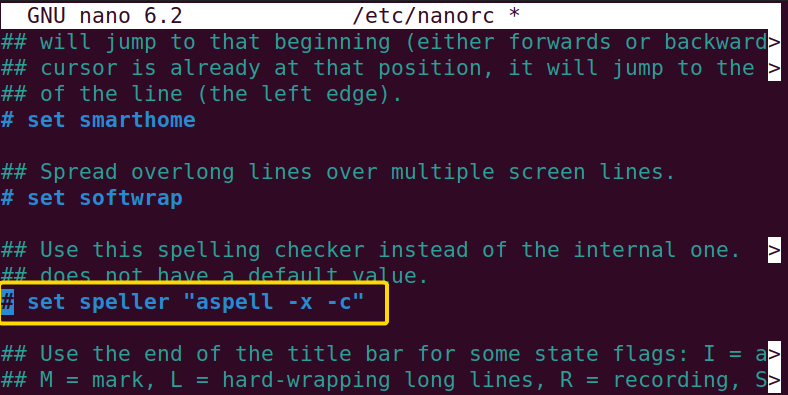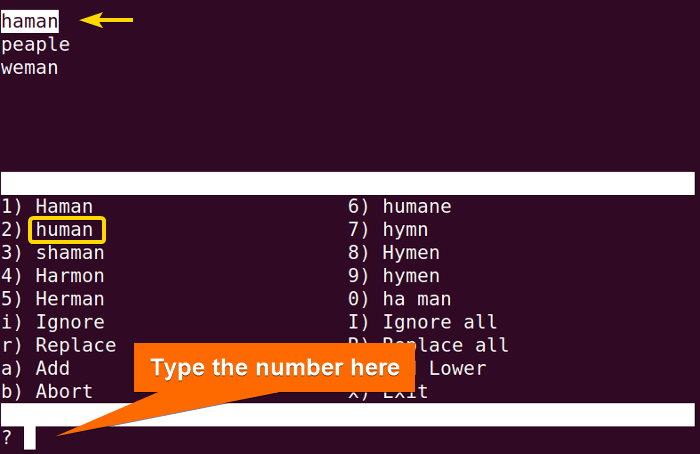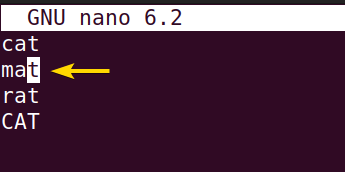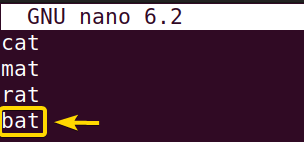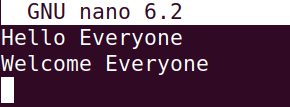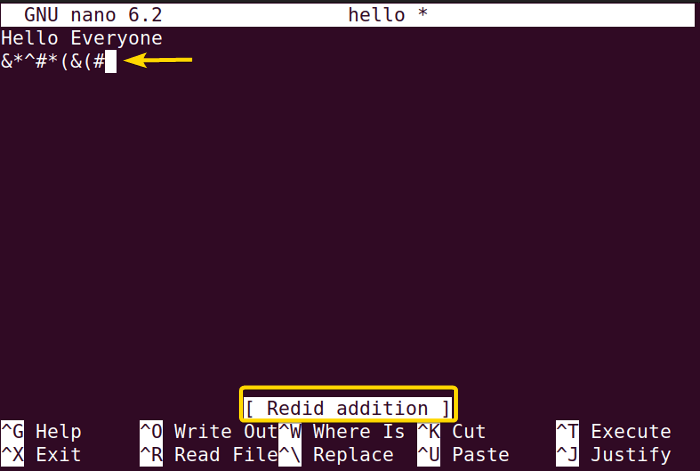FUNDAMENTALS A Complete Guide for Beginners

Nano is the simplest text editor, especially for beginners. However, some advanced features make it suitable for advanced users as well. There are other text editors like Vim and Emacs which are hard to use and it takes a lot of time to get used to them. You can access “nano” text editor using the nano command in Linux. Here I will show you some practical examples of the nano command which may help you with your day-to-day needs.
A. Description
Nano is a common tool in Unix and Unix-like operating systems. Whether you are a beginner or an advanced user, you need a text editor on daily basis. The nano command in Linux is suitable for simple tasks like creating a new file, quickly picking into a file and editing it. Features like copying, pasting, searching, replacing, and spell-checking make it super useful. Moreover, nano command in Linux can be used for a lot of types of files such as txt, html, sh, css, js, py etc.
B. Syntax
The nano command in Linux is simple to use. You can provide it with multiple options, and open multiple files. If you can put the cursor on a specific line(or column) by adding the line number(or column) with a plus(+) sign. You can also make the string case insensitive by adding “c” or “r” followed by a plus(+) sign.
nano [OPTION]... [FILE]...
nano [options] [[+line[,column]] file]...
nano [options] [[+[crCR](/|?)string] file]...
C. Options
There are some options available for the nano command in Linux. Even though you will do most of your tasks inside the nano text editor, those options are useful sometimes. You can check those by yourself by typing the command in your command prompt below:
man nanoUseful Options
- -l, –linenumbers (shows line numbers on the left)
- -m, –mouse (enables mouse support)
- -v, –view (open a file in read-only mode)
- -i, –autoindent (indtents a new line automatically)
- -e, –emptyline (keeps line below title bar blank)
- -g, –showcursor (makes the cursor visible)
- -v, –version (shows current version number)
Install Nano Text Editor
The nano command in Linux is a default in many distributions of Linux. However, you can install it manually as well.
➊ First check if you have nano or not
nano --versionYou will get an output like this
➋ If NOT, type the following command in the command prompt:
sudo apt-get install nanoYou will see an output like this, wait until the process is completed.
Practical Examples of the “nano” Command in Linux
Here I will show you some practical examples of the nano command in Linux. I think it will be most effective if you practice them with me. I have also attached the files I worked with down below.
Example 1: Open Single File Using the “nano” Command in Linux
Now I will open a file using the nano command in Linux. Let’s say I have a directory named walid/folder in my home directory. Now I want to open myfile.txt from there. Here is an important note. If the file already exists, nano will just open it. If the file doesn’t exist, nano will create a file of similar name and open it. Follow the steps below:
Steps to Follow >
➊ At first open the Ubuntu Terminal.
➋ Type the following command in the command prompt:
nano walid/myfolder/myfile.txt➌ Now, press the ENTER button.
Output >
After typing the command, you will see a window like this with the cursor at the beginning.
Similar Readings
- The “grep” Command in Linux [10+ Practical Examples]
- The “wc” Command in Linux [15 Practical Examples]
- The “sort” Command in Linux [16 Practical Examples]
Example 2: Saving and Exiting
In my previous example, you learned how to open a file. Now you will learn how to save the file and exit after editing the file. Here I have used the myfile.txt file to demonstrate the procedures. Now, follow the steps below:
Steps to Follow >
➊ At first, launch the Ubuntu Terminal.
➋ Type the following command to open a file
nano walid/myfolder/myfile.txt➌ Press ENTER key and edit it as you wish.
➍ Type the following line in your nano text editor:
Welcome to Linuxsimply➎ Press CTRL + O.
➏ Now, press the ENTER button. The file is saved.
➐ Now to exit, press CTRL + X.
Output >
Here I wanted to save some text. After pressing CTRL + O, my output was like below.
Example 3: Open Multiple Files Using the “nano” Command in Linux
Let’s say you need to work with multiple files and go back and forth. I will use two files hello and welcome for this example. You can open multiple by following the steps below:
Steps to Follow >
➊ At first open the Ubuntu Terminal.
➋ Type the following command in the command prompt:
nano hello welcome➌ Now, press the ENTER button.
Output >
You will see, the files are opened in different tabs. Press ALT + → (right arrow) to go to the right tab and ALT+ ← (left arrow) to go to the left tab. Here, the hello file is opened in the first tab.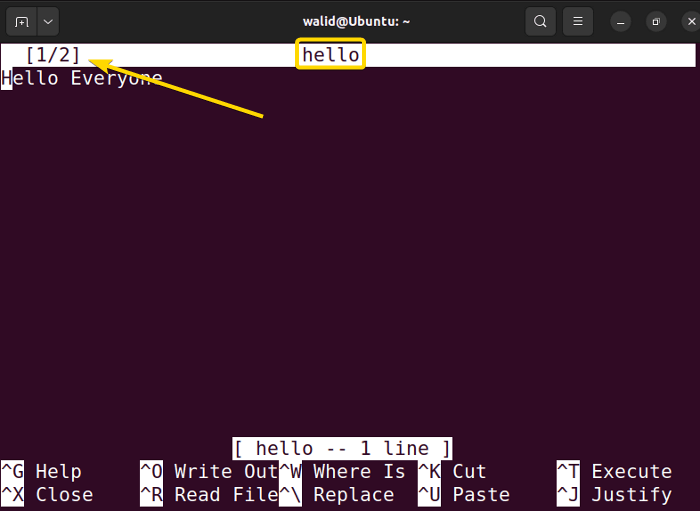
Example 4: Getting Help
The nano text editor has a lot of features. Covering all those features is beyond the scope of this article. That’s why I am going to show how you can find and use them on your own. I will use the hello file here. When you open nano, you see a list of keyboard shortcuts like below:
To know what is the task of a shortcut, follow the steps below:
Steps to Follow >
➊ At first open an Ubuntu Terminal by pressing CTRL + ALT + T.
➋ Type the following command in your command prompt:
nano hello➌ Now press CTRL + G
Output >
You will see a long text like this where every shortcut is explained. To search for anything here, press CTRL + W.
Similar Readings
Example 5: Copy, Cut and Paste in the “nano” Command in Linux
It is possible to copy, cut and paste in the nano command in Linux. Here I will use the file hello here to show how a copy (or cut) a line and paste it.
Steps to Follow >
➊ Af first open your Ubuntu terminal
➋ Type the following command in your command prompt:
nano hello➌ Mark text using the mouse pointer or SHIFT + Arrow keys.
➍ To copy press ALT + 6, To cut press CTRL + K.
➎ Take your cursor where you want to paste.
➏ Press CTRL + K to paste.
Output >
I followed the steps above and copied the first line to the second line. The output is like the below:
Example 6: Search a Word
It is possible to search for a particular thing in the nano command in Linux. I have a file named file which looks like the one below. Now I want to search for the word cat.
Steps to Follow >
➊ At first open an Ubuntu terminal
➋ Type the following command in the command prompt:
nano file➌ Press CTRL + W to search
➍ Include extra feature if you want ( press ALT + C for case-sensitive search, CTRL + T for search by line and column)
➎ Type what you want to search. Here I typed the following word:
cat➏ Then press ENTER
Output >
After pressing CTRL + W, the window will be like below. Here I searched cat. Also, I could have searched using those extra features.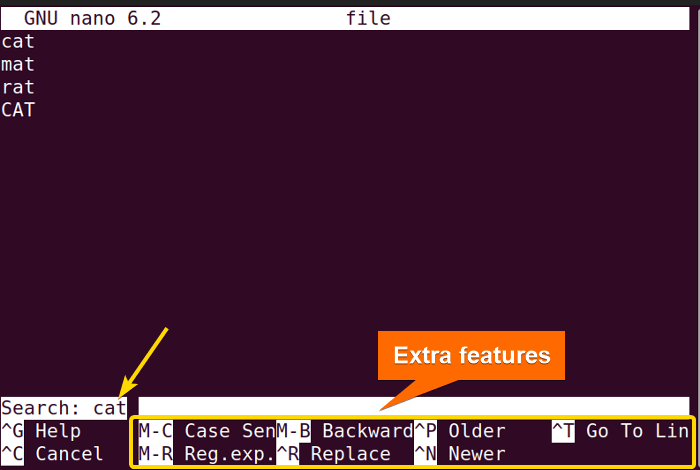
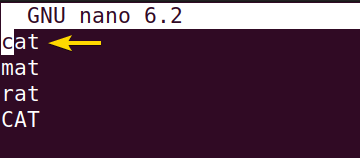
Example 7: Enable the Spell Checker Feature in the “nano” Command in Linux
If the spell checker isn’t enabled you will get an error message like thisTo solve this follow the steps below:
Steps to Follow >
➊ At first launch the Ubuntu Terminal
➋ Type the following command in the command prompt:
sudo nano /etc/nanorc➌ Provide password (if necessary)
➍ Now find the line # set speller “aspell -x -c” and remove the hash “#” symbol from the front.
➎ Then save the file and exit.
Output >
I have attached an image that may help you. You just need to remove the hash “#” symbol. This will enable the spell checker option.
Example 8: Spell Check in the “nano” Command in Linux
Spell checker is a handy tool. Nowadays most of the text has this feature. The nano command in Linux comes with this feature as well. Let’s say there are some lines in the file below and I want to check the spelling. I used the file word here.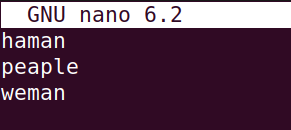
Steps to Follow >
➊ Open an Ubuntu terminal
➋ Type the following command in your command prompt:
nano word➌ Press the key F12
➍ For correction, type the number of the correct word
➎ To abort, type b
Output >
In my case, it is showing a list of suggestions for the word haman, and the current world will be human which is at 2. So I will type number 2 and the word will be corrected.
Example 9: Open a File on A Specific Line and Column
I can go directly on a particular line and a particular column using the nano command in Linux. I will use a file named file for this example. Follow the steps below:
Steps to Follow >
➊ At first press CTRL + ALT + T to open an Ubuntu terminal
➋ Type the following command in the command prompt:
nano +2,3 file➌ Now press ENTER.
Output >
As you can see, the cursor is on the second line and column three.
Similar Readings
- The “vi” Command in Linux [6 Practical Examples]
- The “vim” Command in Linux [8 Practical Examples]
- The “egrep” Command in Linux [10+ Practical Examples]
Example 10: Search and Replace in the “nano” Command in Linux
Searching and Replacing are helpful for any type of user. Good thing nano is also capable of doing those things. For instance, I want to replace the word CAT with bat in the file named file. First I will do a case-sensitive search and then replace the word.
Steps to Follow >
➊ At first open a file in the Ubuntu terminal
➋ Type the following command in the command prompt:
nano file➌ Press CTRL + \
➍ Then press ALT + C to enable case-sensitive search (this step is optional)
➎ Now type a new word and press ENTER.
➏ If you want to replace a single word type Y or for all the words type A.
Output >
Here you can see, I did a case-sensitive search.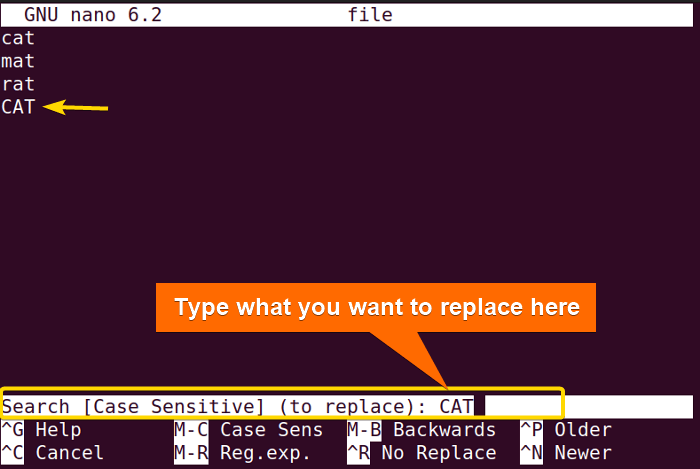
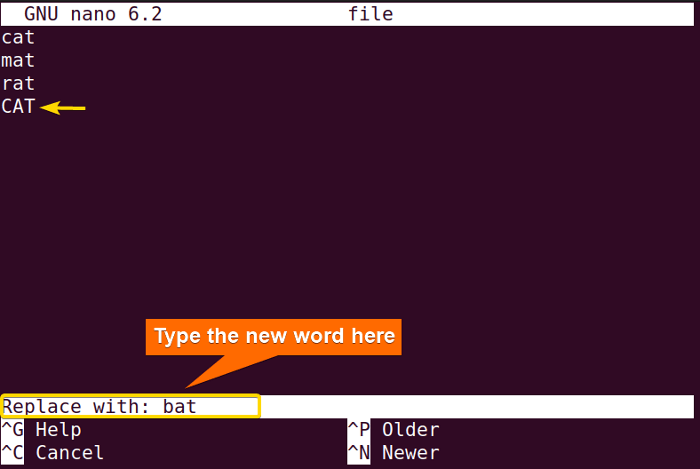
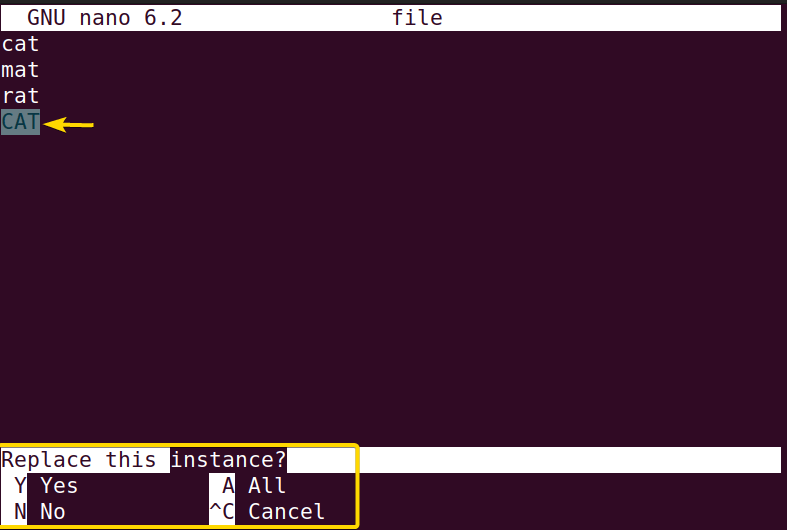
Example 11: Insert Another File
Now I want to copy some text in a file from another file. For this example, I will open a file named hello in my terminal and import text from another file named welcome. You can also practice with me by following the steps below:
Steps to Follow >
➊ At first open your Ubuntu terminal
➋ Type the following command in the command prompt:
nano hello➌ Adjust the cursor
➍ Press CTRL + R
➎ Now enter the file name from which you want to export
Output >
Here, I opened the file hello at the beginning. Then followed step 4 and entered the other filename.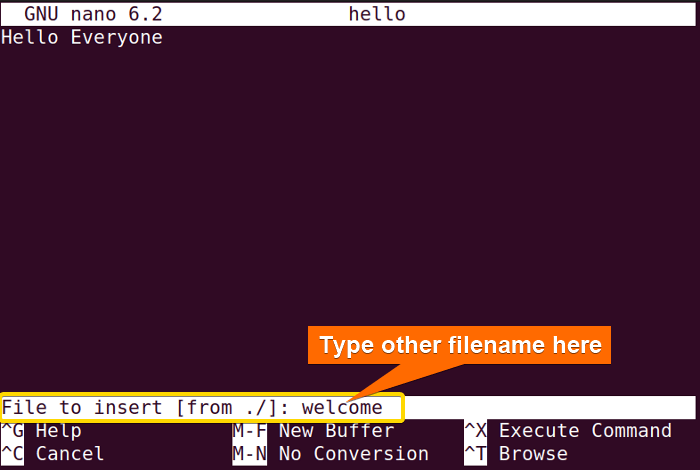
Example 12: Undo and Redo
Undoing and redoing is one of the most useful tools in typing. Everyone uses them. Let’s say I made a mistake while typing, like below. I used the file named file here.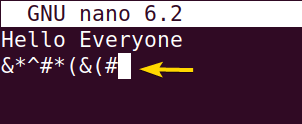
Steps to Follow >
➊ At first press CTRL + ALT + T to open an Ubuntu terminal
➋ Type the following command in your command prompt:
nano hello➌ For undoing press ALT + U
➍ For redoing press ALT + E
Output >
This image shows the output of undoing. You will also see a notification on the screen like below.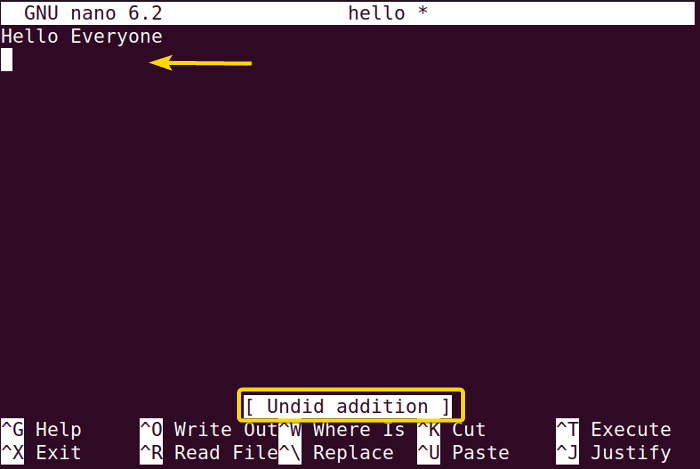
Example 13: Customization of the “nano” Command in Linux
The nano command in Linux is highly customizable. A lot of features aren’t enabled by default. To see the features and enable them, you can always visit the file /etc/nanorc. However, to edit this file, you will need sudo privileges. In this example, I will create a .nanorc file in my home directory and set the following features there
- autoindent – it will automatically indent your text
- casesensitive – it will enable case-insensitive search by default
- historylog – it will keep track of every change
- linenumbers – it will show line number on the left
- mouse – it will enable certain mouse actions
- titlecolor – it will set the title color
Steps to Follow >
➊ Open a terminal in your Ubuntu
➋ Type the following command:
nano ~/.nanorc➌ Now add the following lines:
set autoindent
set casesensitive
set historylog
Set linenumbers
set mouse
set titlecolor red,blue➍ Save the file and exit
Output >
I have also attached an image for you.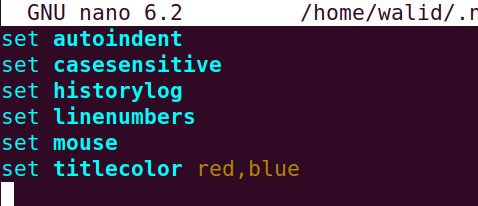
Conclusion
Having some basic skills on a text editor is a must for any type of Linux user. And the nano command in Linux is the most easier text editor with a lot of useful features. Hopefully, the example above will help you master the nano command.
Similar Readings
- The “paste” Command in Linux [6 Practical Examples]
- The “split” Command in Linux [6 Practical Examples]
- The “sed” Command in Linux [7 Practical Examples]
- The “tr” Command in Linux [6 Practical Examples]
- The “uniq” Command in Linux [6 Practical Examples]
- The “printf” Command in Linux [8 Practical Examples]

